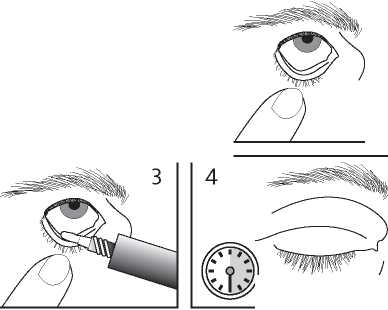Polyfax Ophthalmic Ointment
The following side effects have been reported rarely:
• allergic reactions
Long-term use may cause an increased growth of micro-organisms (germs) that are not affected by Polyfax Ophthalmic Ointment, such as fungi, and this could lead to an infection.
If any of the side effects gets serious, or if you notice any side effects not listed in this leaflet, please tell your doctor or pharmacist.
[2 How to store Polyfax Ophthalmic Ointment
Keep Polyfax Ophthalmic Ointment out of the reach and sight of children. Do not use Polyfax Ophthalmic Ointment after the expiry date which is stated on the carton. The expiry date refers to the last day of that month. Store below 25°C
[6 Further information
What Polyfax Ophthalmic Ointment contains:
The active substances are polymyxin B sulphate 10,000 IU and bacitracin zinc 500 IU per gram of ointment.
The other ingredient is white petrolatum.
What Polyfax Ophthalmic Ointment looks like and contents of the pack
Aluminium tube with screw cap.
Pack size: 4g
Marketing Authorisation Holder
PLIVA Pharma Ltd, Ridings Point, Whistler Drive,
Castleford, West Yorkshire, WF10 5HX, UK.
PACKAGE LEAFLET: INFORMATION FOR THE USER
Polyfax Ophthalmic Ointment
(polymyxin B sulphate and bacitracin zinc)
Manufacturer
Elaiapharm S.A.
2881 route des Cretes, BP 205 Valbonne 06904 Sophia Antipolis Cedex France
This leaflet was last revised in January 2011
PL 10622/0156 87389-C P 1 7699 03
[2 Before you use Polyfax Ophthalmic Ointment
Do not use Polyfax Ophthalmic Ointment if you:
• Are allergic (hypersensitive) to polymyxin B sulphate, bacitracin zinc, other similar antibiotics, or any of the other ingredients of the ointment (see list of ingredients in Section 6). An allergic reaction may include rash, itching, difficulty breathing or swelling of the face, lips, throat or tongue.
Take special care with Polyfax Ophthalmic Ointment (and speak to your doctor) if you:
• are using large amounts of your ointment.
If a large amount of the ointment is absorbed into the body it may cause damage to the nerves and kidneys.
Long-term use may cause an increased growth of micro-organisms (germs) that are not affected by Polyfax Ophthalmic Ointment, such as fungi, and this could lead to an infection.
Taking other medicines
Please tell your doctor or pharmacist if you are taking, or have recently taken, any other medicines, including medicines obtained without a prescription.
This is especially important of the following substances as they may interact with your eye ointment:
• neuromuscular blocking drugs (sometimes used during surgery) - if you have absorbed a lot of Polyfax Ophthalmic Ointment, these drugs will have a greater effect on depressing breathing.
It may still be all right for you to be given Polyfax Ophthalmic Ointment and your doctor will be able to decide what is suitable for you.
Pregnancy and breast-feeding
Tell your doctor if you are pregnant or breast-feeding. Ask your doctor or pharmacist before taking any medicines.
Driving and using machines
There are no known effects on driving or using machines.
^ How you use Polyfax Ophthalmic Ointment
Dosage
Always use your ointment exactly as your doctor has told you. You should check with your doctor if you are unsure.
Read all of this leaflet carefully before you start taking this medicine.
• Keep this leaflet. You may need to read it again.
• If you have any further questions, ask your doctor or pharmacist.
• This medicine has been prescribed for you. Do not pass it on to others.
It may harm them, even if their symptoms are the same as yours.
• If any of the side effects gets serious, or if you notice any side effects not listed in this leaflet, please tell your doctor or pharmacist.
In this leaflet:
1. What Polyfax Ophthalmic Ointment is and what it is used for
2. Before you use Polyfax Ophthalmic Ointment
3. How you use Polyfax Ophthalmic Ointment
4. Possible side effects
5. How to store Polyfax Ophthalmic Ointment
6. Further information
j What Polyfax Ophthalmic Ointment is and what it is used for
Polyfax Ophthalmic Ointment is an eye ointment, which contains the active ingredients polymyxin B sulphate and bacitracin zinc. Polymyxin B sulphate and bacitracin zinc are antibacterials.
Polyfax Ophthalmic Ointment is used for the treatment of bacterial infections of the eye and adjoining parts such as conjunctiva and eyelids, including:
• conjunctivitis (inflammation of the lining of the eye - red eye)
• keratitis (inflammation of the cornea of the eye)
• corneal ulceration (damage to the surface of the cornea)
• ulcerative blepharitis (damage to the eyelids)
Your ointment may be applied both before and after an eye operation (including the removal of foreign bodies) to prevent infection.
Polyfax Ophthalmic Ointment may be used with other treatments if suitable.
Adults and children
Wash your hands before and after applying Polyfax Ophthalmic Ointment.
A thin film of ointment (1 cm) should be applied to the affected part or inside of the lower eyelid (as shown in the diagram).
If you find this difficult, it may be easier if a mirror is used or for someone else to do this for you. Try to avoid letting the tip of the tube touch any part of the eye.
After application, close your eye for 30 seconds. This should be repeated two or more times a day depending on how severe the infection is.

Treatment should be continued until at least two days after the eye appears to be uninfected.
If you have any further questions on the use of this medicine, ask your doctor or pharmacist.
4 Possible side effects
Like all medicines, Polyfax Ophthalmic Ointment can cause side effects, although not everybody gets them.
All medicines can cause allergic reactions, although serious allergic reactions are very rare. Tell your doctor straight away if you get any sudden wheeziness, difficulty in breathing, swelling of the eyelids, face or lips, rash or itching (especially affecting your whole body).